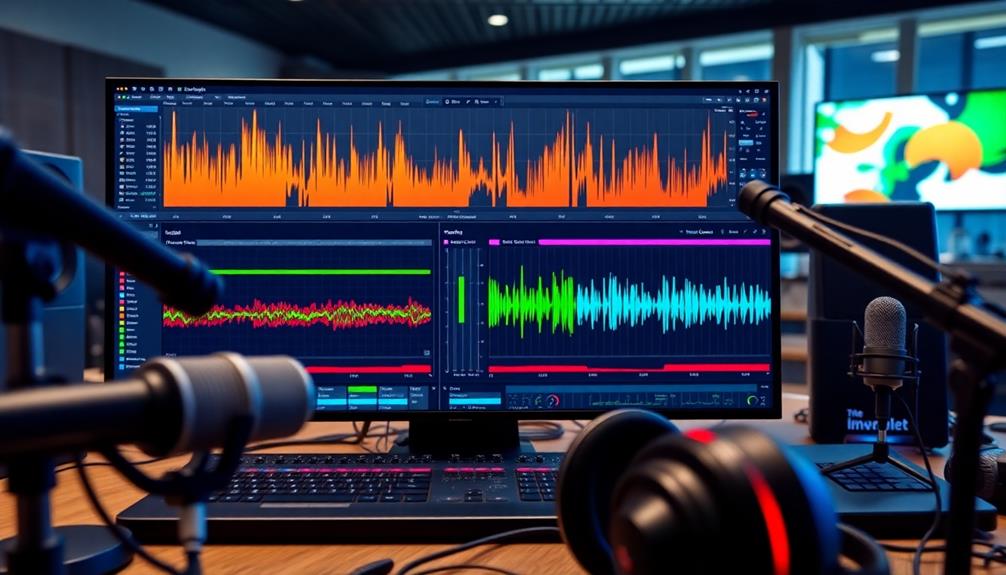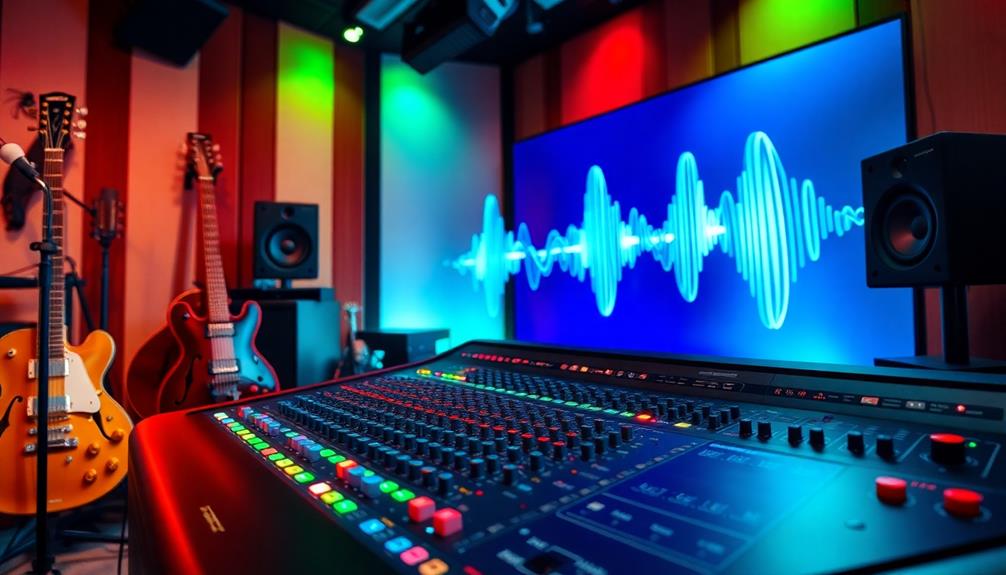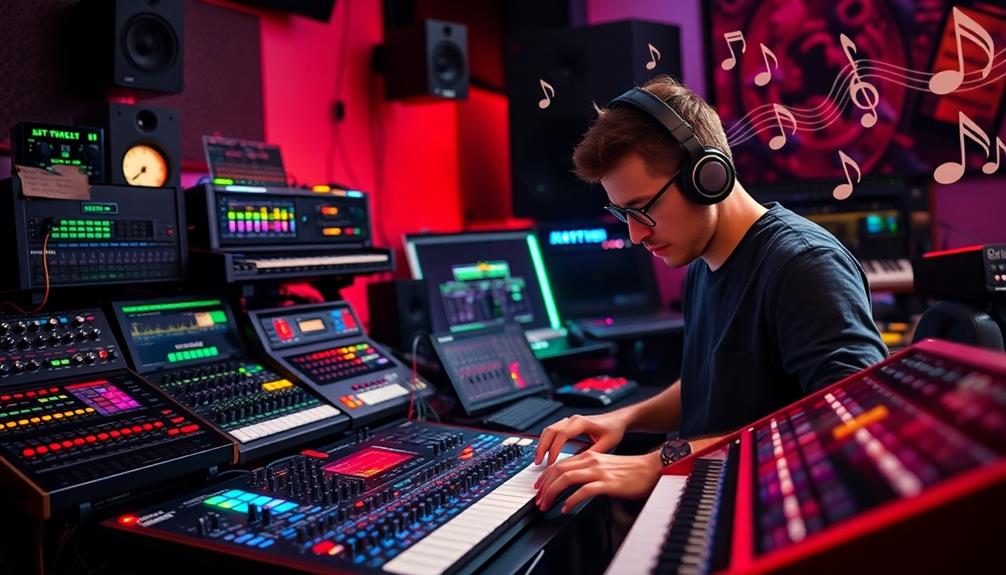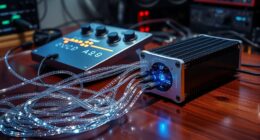To master advanced vocal tuning techniques with Auto-Tune, you need to grasp its key functions. Start by adjusting the Retune Speed for natural pitch correction and use Flex Tune to soften harsh adjustments. If you're working on EDM tracks, try the "Set and Forget" method on your settings, while singer-songwriters should focus on precise pitch tweaks. Don't forget to use the Humanize feature to keep emotional expression intact. Experiment with the Natural Vibrato knob for added flair, and your performances will shine. There's so much more to explore for perfecting your sound, so keep going!
Key Takeaways
- Utilize Graph mode for precise pitch adjustments, allowing for detailed customization of vocal performance and unique sound shaping.
- Experiment with varying Retune Speed settings; lower speeds maintain natural sound while higher speeds create a more polished effect.
- Adjust Flex Tune to find the right balance between correction and warmth, enhancing vocal integrity without sounding overly processed.
- Implement the Humanize feature to stabilize pitch in sustained notes, preserving emotional expression and making performances feel more authentic.
- Combine genre-specific tuning methods; for example, use robotic stacks in Trap while focusing on warmth for Singer-Songwriter tracks.
Overview of Auto-Tune

Auto-Tune revolutionized the music industry when it was introduced by Antares Audio Technologies in 1997, primarily serving as a tool for pitch correction in vocal performances.
It's become the industry standard for achieving polished sounds across genres like pop, hip-hop, and R&B. With the latest version, Auto-Tune Pro, you get real-time pitch correction capabilities, allowing you to make immediate adjustments during both live performances and recordings.
Auto-Tune supports two modes: an automatic correction mode and a Graph mode for manual pitch adjustments. This flexibility lets you tailor your approach to vocal editing, ensuring the best results for your project.
One of the standout features is the customizable Retune Speed, which helps maintain a natural pitch when correcting vocal issues. You can also fine-tune note detection settings to preserve the unique qualities of each vocalist.
Compatible with various digital audio workstations (DAWs), Auto-Tune is a go-to tool in music production.
Whether you're a seasoned producer or just starting out, mastering Auto-Tune can elevate your vocal performances and transform your tracks into professional-sounding masterpieces.
Key Knob Functions
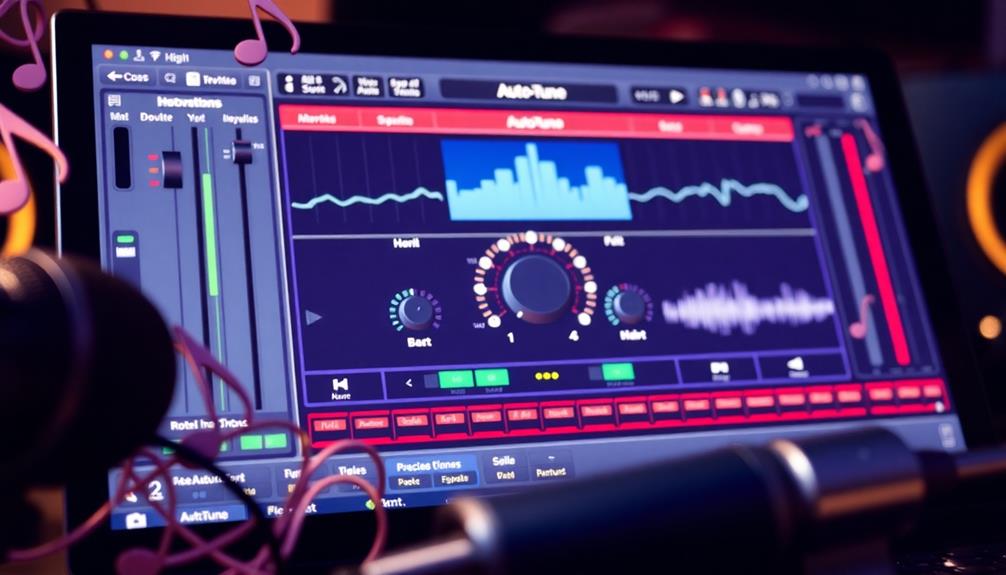
Understanding the key knob functions in pitch correction tools can greatly enhance your vocal production process.
Start with Retune Speed, which determines how quickly pitch correction is applied. Lower settings yield a more natural sound, while higher settings create that recognizable Auto-Tune sound. For organic genres, a value around 25 is recommended.
Next, explore Flex Tune, which softens harsh pitch corrections, allowing for a more authentic vocal effect. A starting setting of 60 helps strike a balance between pitch correction and vocal quality.
Humanize is vital for stabilizing pitch during sustained notes, reducing unwanted wavering. A high Humanize setting of 75 is essential for maintaining emotional expression, especially in choruses.
Lastly, adjust Natural Vibrato to control vibrato presence in your track. Negative values can eliminate unwanted fluctuations while preserving expressive vibrato.
Genre-Specific Tuning Methods
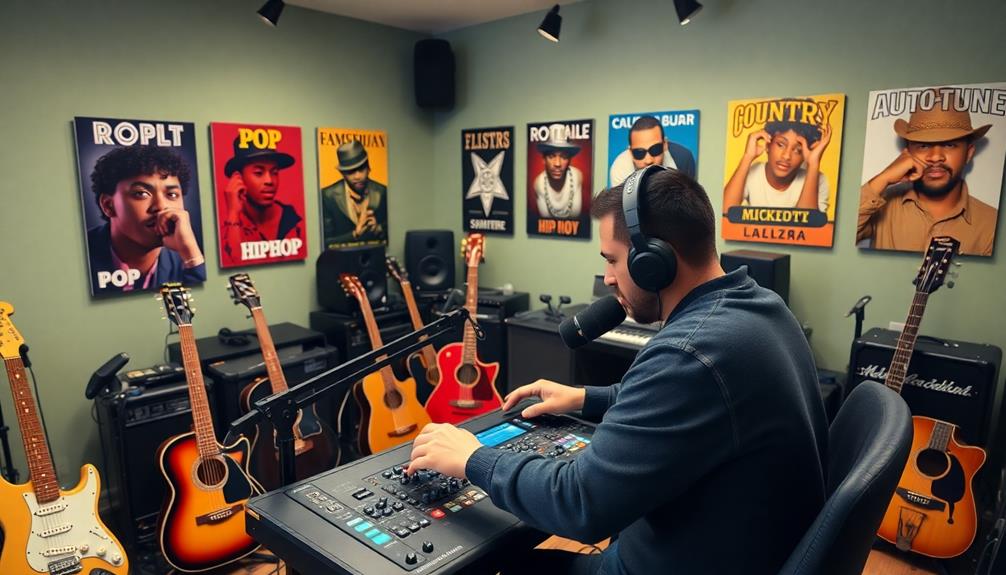
Exploring genre-specific tuning methods is essential for achieving the right vocal sound in your productions. Each genre has its unique requirements, and understanding these can elevate your work considerably.
Here are four key approaches to reflect upon:
- EDM Tracks: Use a "Set and Forget" method. Adjust the Retune Speed and Flex Tune to enhance warmth while allowing real-time vocal tuning.
- Singer-Songwriter Tracks: Focus on careful pitch adjustments. Master the Key and Scale settings to correct pitch without losing that natural vocal performance.
- Trap/Dubstep Techniques: For a robotic vocal effect, stack your settings. Set Retune Speed to 0 and minimize Flex Tune for clarity and pitch control.
- Vocal Section Variation: Slice vocals into separate tracks. This allows you to apply different tuning methods for various sections, aligning with the emotional dynamics of your song.
Enhancing Vocal Performance
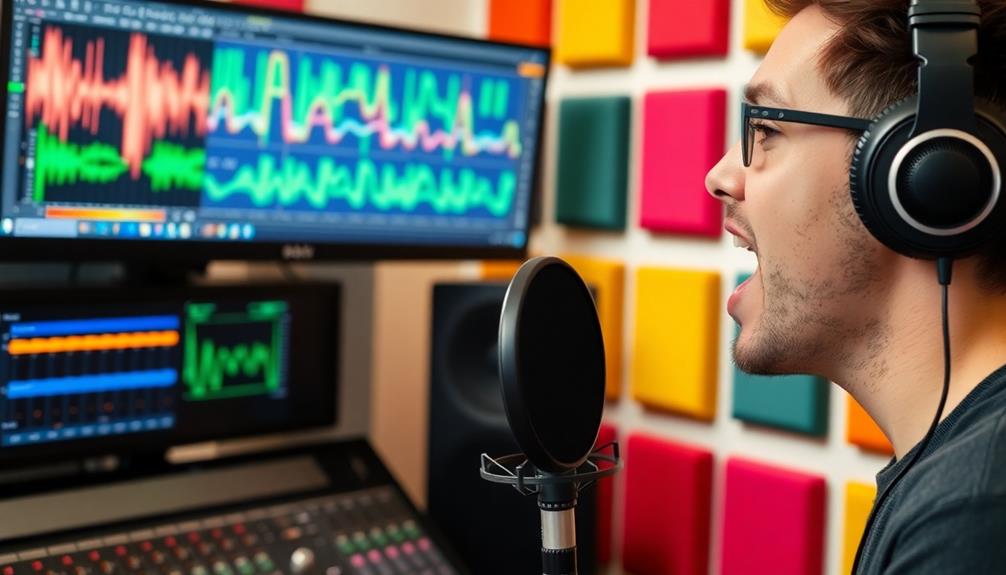
Enhancing vocal performance is essential for creating impactful music that resonates with listeners. To achieve this, you can use Auto-Tune's features to refine your vocal tracks. Start by adjusting the Retune speed; a slower Retune Speed around 25 can improve the quality of your sound, giving it a more natural feel without the robotic artifacts that come from faster settings.
Utilizing the Humanize feature stabilizes pitch during sustained notes, preserving the emotional expression important in choruses. For vocal texture, tweak the Natural Vibrato knob to create vibrato. Positive settings amplify vibrato effects, while negative settings smooth out unwanted fluctuations, ensuring an authentic delivery.
Flex Tune adjustments are also essential, as they help maintain warmth and natural variations in your voice, aligning with your unique style.
Experimenting with vocal customization techniques, like fine-tuning pitch in Graph mode, can lead to distinctive performances. By carefully balancing these Auto-Tune settings, you can enhance your vocal performance, making your music not only polished but also deeply engaging for your audience.
Professional Mixing and Mastering
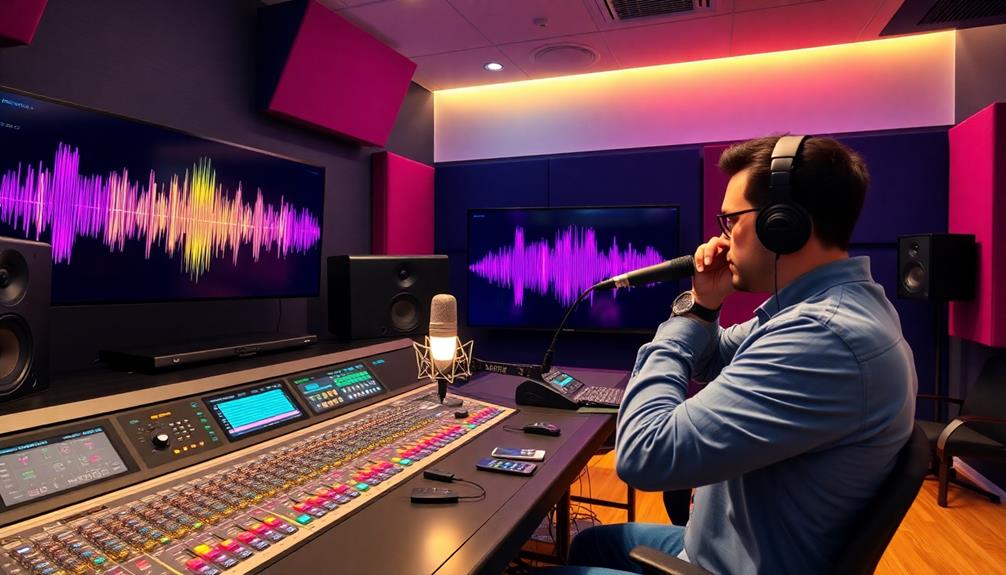
Professional mixing and mastering are essential components of music production that can elevate your tracks to new heights. When done correctly, these processes guarantee your vocals shine and blend seamlessly within the overall soundscape.
To achieve the best results, it's important to reflect on the acoustics of your recording environment and the equipment used during production, as these factors can greatly impact sound quality. Additionally, utilizing techniques from advanced cleaning technology can help maintain clarity and precision in your recordings.
Here are four key benefits of professional mixing and mastering:
- Balanced Sound: Achieve a well-balanced mix that highlights the pitch of the vocal and the desired sound.
- Natural Correction: Use Auto-Tune for seamless pitch correction, guaranteeing a natural yet polished vocal performance.
- Expert Techniques: Experienced engineers apply EQ, compression, and reverb to create engaging sound effects that meet industry standards.
- Testing on Systems: The final mix should be tested across various sound systems to maintain clarity and dynamics.
Utilizing software like Pro Tools, professionals can enhance your corrected vocal tracks with speed and precision.
Trusting industry experts for professional mixing and mastering not only boosts your song quality but also leverages high-end tools for ideal results. By integrating these advanced techniques, you'll guarantee your music resonates with listeners, ultimately leading to greater success in your musical endeavors.
Frequently Asked Questions
What Is the Most Natural Sounding Auto-Tune Setting?
To achieve the most natural sound with Auto-Tune, aim for a Retune Speed around 25, a Flex Tune value of 60, and use the Humanize feature set high. Balance is essential for authenticity. Experiment to find your perfect settings.
Do Professionals Use Auto-Tune?
Absolutely, you'll find that professionals frequently favor Auto-Tune, effortlessly enhancing every alluring element of their tracks. It's a go-to tool for many artists, allowing for polished performances and captivating creative choices in modern music.
How to Make Auto-Tune Sound Better?
To make Auto-Tune sound better, adjust the retune speed for natural corrections, utilize Flex Tune for nuances, and apply the Humanize function to maintain emotion. Experiment with key settings to enhance vocal integrity and accuracy.
What Is Better Than Auto-Tune?
If you're looking for alternatives to Auto-Tune, consider Melodyne for detailed pitch editing, Waves Tune for a natural sound, or iZotope Nectar for thorough vocal processing. Each offers unique features that enhance your vocal tracks.
Conclusion
In mastering advanced vocal tuning techniques with Auto-Tune, you'll find that precision and creativity coexist. While the technology can sharpen a pitch, it can also soften the raw emotion of a performance. Striking a balance between technical perfection and artistic expression is key. Embrace the power of Auto-Tune to enhance your vocals, but don't forget the soul that makes your music resonate. Ultimately, it's this interplay that elevates your work from mere sound to unforgettable art.

